Women in NAP The first woman Nappie, Gina Maranto '77 #807, writes about her personal experience and the compelling story of the events surrounding the fall of the Nu Alpha Phi gender barrier. In real life, Gina is a respected, Miami-based science writer whose recent book, "The Quest for Perfection: the Drive to Breed Better Human Beings," was published last Summer by Scribner.
|
Twenty years ago this past fall, the Nappies went co-ed. I was the first female assigned a maggot number (807), and although the official roster is somewhat confusing on this score1, my co-partner in the honor (or crime?) of joining this formerly all-male organization was Martha McNulty, an extraordinarily talented artist whose name for some reason is not found on the rolls until the next round of inductions, when Anne Cheadle, la femme troisiëme, also joined. Although my memory is spongiform on this score, I'll go on to add that I recall that at least Martha and I were initiated together in the spring of 1977 at a ceremony presided over by Gustav Niebuhr, newly returned from a stint at Oxford to take up his post as head of the Nappies. Along with other inductees at a somewhat improvised ceremony, Martha and I bent over, and Gus, now a religion reporter with the New York Times, applied a wooden paddle to our posteriors (though we wouldn't want his sources in the Christian Coalition to hear about that phase of his career). Plastic champagne glasses were raised, and three years later, alumni Nu Alpha Phis were still fuming about the whole affair-and ultimately a few severed their ties with the fraternity. Indeed, the addition of women was probably the most convulsive event in the fraternity's history-if less traumatic for the actives than the assorted assaults on the Wash over the years. At the time, I was aware that the decision to go co-ed had inflamed certain alumni; that one influential alum had threatened to withdraw a promised scholarship from the college; and that Walt Zabriskie, a.k.a. Zibby (then editor of the Oak Leaf), was playing crisis mediator, in which capacity he eventually asked me and several actives or recently graduated NAPs (then-president John Popp, Tom Strouse, ex-secretary/treasurer Geoff Levin, among others) to write explanatory letters that, it was hoped, would placate the Outraged Elders. What only recently became clear to me, after I reviewed copies of the correspondence having to do with the issue, was how bitterly betrayed some alumni felt, how tirelessly some of them denounced the move to admit women, and how zealously a select few strove to make their dismay and anger known. At the same time, a sizable number of alums eloquently defended the actives and their decision, including a few of the very oldest NAPs.
Principally, the alumni objected to the invasion of their male version of the hariim (Arabic for sanctuary, and generally referring to the room deep in a Middle Eastern house where women are hidden from the gaze of male strangers). Several letter-writers described the fraternity as a "retreat, refuge, and haven from women," a function that they clearly deemed vital to their psychological well-being and that (somehow, they seemed to be saying) could be violated retroactively. Again and again-there seems to have been a lot of letter swapping and dictating going on, sort of on the model of activist groups that provide supporters with wording for letters to their Senators-the opponents proclaimed the categorical impossibility of women being part of a fraternal organization. Wrote one alum, "In spite of equal rights and Women's Lib, your sister cannot be your brother." This has a very nice ring indeed, and the kind of ontological indisputability that one normally finds only on bumper stickers. In addition, the degeneration of the fraternity into a "social club" was repeatedly bemoaned. In trying to understand the alumni response, I take this last point as key, but more on that later. Alums variously deemed the seven actives who had voted to go co-ed (the vote was seven yeas, three nays) audacious, "completely nuts," perfidious, and thoughtless. One argued that what had happened to Nu Alpha Phi was akin to the advent of co-ed dorms on the Pomona campus, which he claimed occurred as a result of "pressure exerted by the undergraduate neo-adolescents, intent upon carrying their banner of License Unlimited beyond any and all boundaries bearing the labels of 'traditional,' 'established,' 'customary,' 'generally approved.'" At bottom, many alumni felt, the actives had disrespected NAP tradition. The chief problem in this line of argument was that by the 1970s there was no tradition immediately perceivable to those on the ground in Claremont, fraternities being life forms not unlike slime molds. Slime molds form colonies and, at a certain point in their life cycle, construct fruiting bodies which send out spores which in turn form colonies which, at a certain point...et cetera. The genetic line persists from colony to colony, but that doesn't mean that slime mold cells from different generations would necessarily recognize one another were they to cross paths-or even want to step down the street and have a beer together (apologies to Thomas Pynchon). This is meant in the least sacrilegious sense, and anyone who might want to take offense should recall that we Nappies have been classified not only as sagehens but also as maggots. But I digress. The point is that in the early '70s, the only brother from an earlier generation in real evidence on campus was self-described "old hippie" Zabriskie.4 Although Zib provided actives with a sketchy oral version of the frat's history and the occasional thumbnail portrait of the early movers and shakers, there was no written history until he undertook to commission one around 1976 or so. While the actives were in possession of the by-laws, the details and significance of such ceremonies as "The Camel's Walk" had long since been forgotten (maybe with good reason?). Nobody knew from carving paddles, and the secret handshake was a source of confusion even to those who were supposed to be in the know. Meanwhile, by fall semester 1976, the Claremont fire marshal had declared the fraternity rooms off limits to more than ten people because they lacked sufficient fire exits; the college wanted to convert the rooms to lounges.5 Up in dusty San Dimas Canyon, the cabin had fallen into disrepair and been vandalized. Membership in NAP had steadily dwindled.
The only real signs of life came from the Wash, and it was there that a whole gang of Smiley denizens, including Tom Phalen and Ev Hoffman (who were freshman roommates), John Popp and Rick Counihan (who would go on to host a riotous radio show together), Bob Barker (a Mudd-Blaisdell resident but Smiley habituÈ), Gus Niebuhr (who moved out to Harwood second semester), Bob Nigbor, and me, among others, first heard about Nu Alpha Phi. By 1975, in the spring of my sophomore year, we Smileyites had two Friday rituals which taken together made up a functionally counterintuitive (or should that be intuitively counterfunctional?) day: We got our clean sheets for the week in the morning and spent the afternoon at the Wash. Rick, Ev, and I were so enamored of the latter part of this end-of-the-week activity that we actually attempted to reconstitute it the following year at Swarthmore, where we all went on exchange. Our efforts were small-scale: We'd buy a case of brew at Sproul Beer Mart and take it to the Greek theater, which had been providently provided for such eventualities by the college's Quaker founders. More often than not, total "East Coast Wash" attendance did not exceed three, although sometimes we wound up accommodating a wild Englishman named Ian and a couple rowdy Texans, Martin and Martha, on exchange from Rice University. However, we were definitely emulating the more exalted model that had been elaborated by NAP kegmeisters. (Rick and Ev would go on to join this legendary breed.) By the time the three of us returned to Pomona for the '76-'77 year, Niebuhr, Popp, and Nigbor had already joined the frat, as had Tom Phalen, now a criminal defense lawyer in Phoenix. Tom had been rushed in the fall of '75, but had then departed for an exchange semester at Colby in Maine. He recalls that he was "schooled enough in feminism to be ashamed to be part of an all-male institution." So, back in Claremont in fall '76, he proposed that women be accepted into the frat-a suggestion that he recalls sparked little opposition. Popp says that Phalen's argument for admitting me specifically centered on my pivotal role re: the Wash. I'd turned 21 the summer before senior year and by happy circumstance also happened to have a car, a Fiat the color of oxidized copper that had already made it back and forth across country a couple times. Thus endowed with reliable transport, I frequently played designated driver and keg-buyer on those critical Friday afternoon runs to Arrow Meat Co. According to Popp, Tom argued that "Gina drives down to get the beer," and that in recognition of my involvement I should be made an official member of NAP. In fact, although the actives didn't know it, at least one other woman had made major efforts on behalf of the frat in the past and been elected an honorary member. According to one alum, she was "Brad Datson's aunt, Mrs. Davis (head of the dorms when we were in school)," and "gave us Nu Alphs so many preferential dorm jobs!" But now the actives were going definitively to change the code. There were three hold-outs in the final vote, but based on what Tom says, one may assume they didn't express their opposition with any great heat. Gus says that when he became president in spring '77, having women in the frat was a fait accompli. His prime concern wasn't the co-ed issue; instead he was focused on getting the frat moving again as a viable campus entity and also, especially, rehabilitating the cabin, which had been trashed by unknown locals, who had liberally exercised their right of free speech in spray-paint on the interior walls and the bar. We all hove to and did a lot of scut work to improve the place, along with the help of several alums. But raising money for further repairs remained key, and the actives put their energies into on-campus events that could help fill the petty cash drawer.
When Phalen approached me about joining Nu Alpha Phi I remember being surprised and flattered, but also befuddled at what to do. Join a fraternity? Me? Exclusionary clubs, all-male or otherwise, didn't exactly figure high on my All-Time Hits List. For that matter, favoring a morose, cynical, clinically depressed outlook which seemed befitting to my writerly ambitions, I generally considered all human organizations unsavory. Fraternities were outmoded at best; examples of elitist, sexist, anti-intellectualism at worst. (Of course, one didn't overlook the fact that attending Pomona itself was hardly an act qualifying one for membership in the lumpen proletariat.) After mulling the offer over, though, I decided it made some sense. In effect, we former Smileyites, who made up the largest bloc of the frat in '76-'77, weren't so much joining an exclusionary club as grafting the club to us. We had already forged a tight network of friendships on our own; becoming Nappies was a way of formalizing those friendships. Maybe it was even a way of memorializing them, because even in those days some of us were beginning to have thoughty conversations about the future. I remember particularly a long talk Counihan and I had driving north on the Bloody Bayshore on some visit to the Bay Area, in which we wondered how long our college friendships-which for me and I think for Rick, too, were predominantly Nappie friendships-would last after graduation. As it turns out, some of them have not only lasted these twenty years but flourished. Being able today to say we were Nappies does convey a greater significance to those long-ago relationships than had we simply been friends. The degree to which it does so may not be large, but is certainly measurable, else I wouldn't even have been asked to write this piece. I suppose a therapist trained in the Freudian school might discern other reasons for my having joined. All that discredited stuff about penis envy might enter into the analysis. And it's true that I had, for most of my college career, aspired to be just one of the guys. On the other hand, as the historical dynamic unfolded, it wasn't I who agitated for admission, rather the actives who sought to expand the boundaries of the frat. So maybe it was more the case that the guys aspired to be one of the femmes, or at least to embrace, in more than a merely physical way, attributes that they mentally assigned to the opposite sex. And the method they settled on for doing that was to invite us in. Maybe they made us brothers so we could, in turn, make them sisters?
This interpretation seems to jibe with what was going on in the larger universe, outside the Pomona campus, although I was interested to hear from fellow NAP Marla Stone, class of '82, whom I happened to meet in Miami last summer as she was on her way to the American Academy to collect on her Prix de Rome, that joining the frat was still, for her, a "transgressive act." So the bunkers of all-male privilege apparently weren't succumbing to the female assault all that speedily. If I transgressed, it was pretty much unconsciously (some might argue that I cruised that psychological zone almost exclusively while at Pomona), but I suppose if we don't too strenuously press the point, we have to accept that Martha and Anne and I and other early Nappettes did cross a line, boldly going where no women had previously gone. I suppose, too, we may appear as quaint to the current actives as our NAP forerunners did to us. Which brings me back to that curious business about fraternities versus social clubs. Some alums were nearly rabid about this point.6 Wrote one, "I would rather set up a fund to provide hot meals for wineos [sic] rather than to honor a mongrel student club." Fraternity? Club? What was the difference? Twenty years down the line, Popp, even without having seen the correspondence, remembers how frequently the fraternity/social club opposition came up. "It was really strange and interesting, that they should have been so vehement about that," he says.
I didn't actually get the distinction until I ran across Secret Ritual and Manhood in Victorian America (Yale University Press, 1989) by Mark Carnes, who was at the time of the book's publication an associate professor of history at Barnard. This study of fraternal organizations like the Freemasons, Odd Fellows, and Knights of Pythias has much to say about the ways in which the roles and attributes of men and women were defined in mid- to late-nineteenth century America. Romantic in origins, the view of women advanced by Masons especially was as domestic idols who "protected the home from masculine aggression and materialism." An essential tenet was that woman was pure and man was base; therefore, woman was incontestably "better" than man, which is to say morally superior to him. (As I read Carnes, all this began to look familiar: My maternal grandfather was a Mason, and his outlook, I can now see, was heavily influenced by such ideas.) Under this idealistic scheme of True Womanhood, women had to be excluded from fraternal organizations. Explains Carnes, "If...man was a 'rough ashlar,' requiring the intellectual and spiritual polishing of initiatory ritual, woman, already a jewel, had no need for the rites of the lodge." Carnes adds, "One character in a story about Freemasonry tells women, 'You were born Masons; any initiation or ceremony would be superfluous; therefore we do not insult you by any such propositions.'" Men, in joining fraternal organizations, and, one infers, some fraternities, aspired to ascend by positive association with their brothers into that moral realm that women already occupied. One infers the corollary that the presence of women would actively prevent that process from taking place.7 Interestingly, one of the most adamant opponents of going co-ed cites a Masonic publication in one of his letters. Dim echoes of these Victorian notions can be heard in the letters written by some older NAPs in objection to the co-ed issue: Men and women are not interchangeable puzzle pieces, declares one brother. Don't get me wrong, writes another, I love women: I married one and have daughters; I just don't want them in my fraternity. In addition, wrapped up in these statements is dismay and confusion over the fact that the old categorical distinctions were being ignored-or flouted. Beneath the anger is a tone of mourning. Something precious was being lost. Redefining assumptions and embracing new values: these are acts which drive social change, and the guys who engineered the entry of women into Nu Alpha Phi engaged in them. And in time, some group of actives will once again redefine assumptions and embrace new values. I wonder how I would feel if, for example, NAP were declared an all-male organization-or all-female? Or if members, in a time of anti-immigrant backlash, decided to accept only Anglo members; or in a time of fundamentalism, only Christian? None of those hypothetical events strikes me as appealing because they are sexist, segregationist, racist, and diminish rather than enlarge; in fact, they all sound censurable, and would, to me, signal that something profound had gone wrong with society at large.
But I have always seen the addition of women in a different light, which only figures. In September 1978, I wrote a letter which may or may not have been published in the Oak Leaf at the time. But since it's the only document that I've been able to find which describes my feelings at the time (my journal for that period seems to have gone missing), it's worth quoting from: "As I see it, the fraternity performs two main functions...both fundamentally related to Homo sapiens' basic need for community. One is service to the college as a whole, the other is service to the fraternity itself....The addition of women to the bunch means the multiplication of energy to spark events: The more enthusiastic actives there are, the healthier the entire Nappie family will be....I was not defiling a preserve by being the first female to join, but enriching a society and, at the same time, being enriched by it." Though the prose has a distinctly purple hue, especially when I go into a riff about "the supportive sodality" and "lasting community of 'brothers' akin in purpose," I wouldn't entirely disown the attitudes I expressed then. No need to wax nostalgic, but the Nappies I knew, and continue to know, were, and are, the best of people. And I suppose even a cynical writer might be permitted to aver that there is a NAP spirit, wherever NAPs are together, and it is by and large a force for the good. Gina Maranto '77 #807, email_deleted |
![[ Nu Alpha Phi ]](../../NAP.gif)
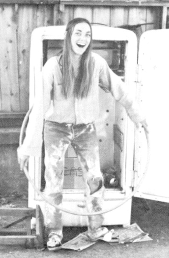
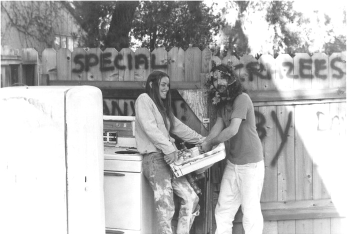
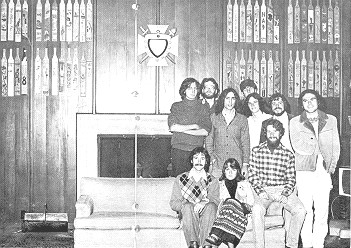
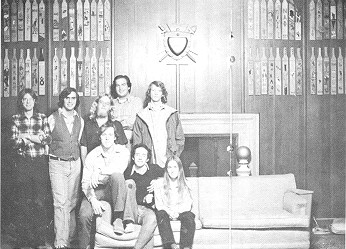
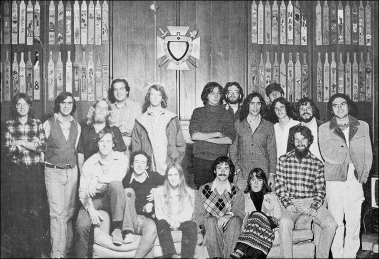
 ] [ Contents ] [
] [ Contents ] [  ]
]
